Unit 1 I went to Sanya for my holidays 教案(6个课时)
文档属性
| 名称 | Unit 1 I went to Sanya for my holidays 教案(6个课时) |
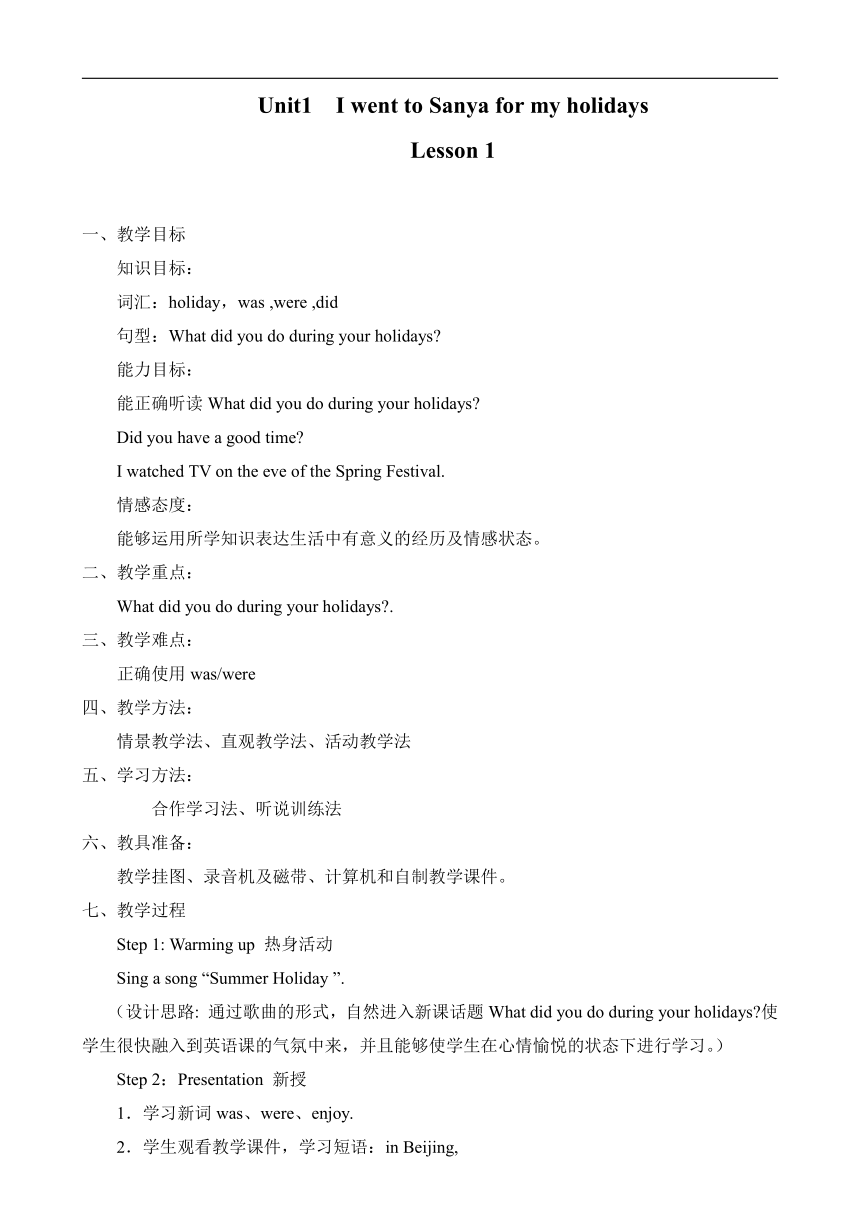
|
|
| 格式 | zip | ||
| 文件大小 | 80.5KB | ||
| 资源类型 | 教案 | ||
| 版本资源 | 人教精通版(三年级起点) | ||
| 科目 | 英语 | ||
| 更新时间 | 2019-04-25 09:44:26 | ||
图片预览

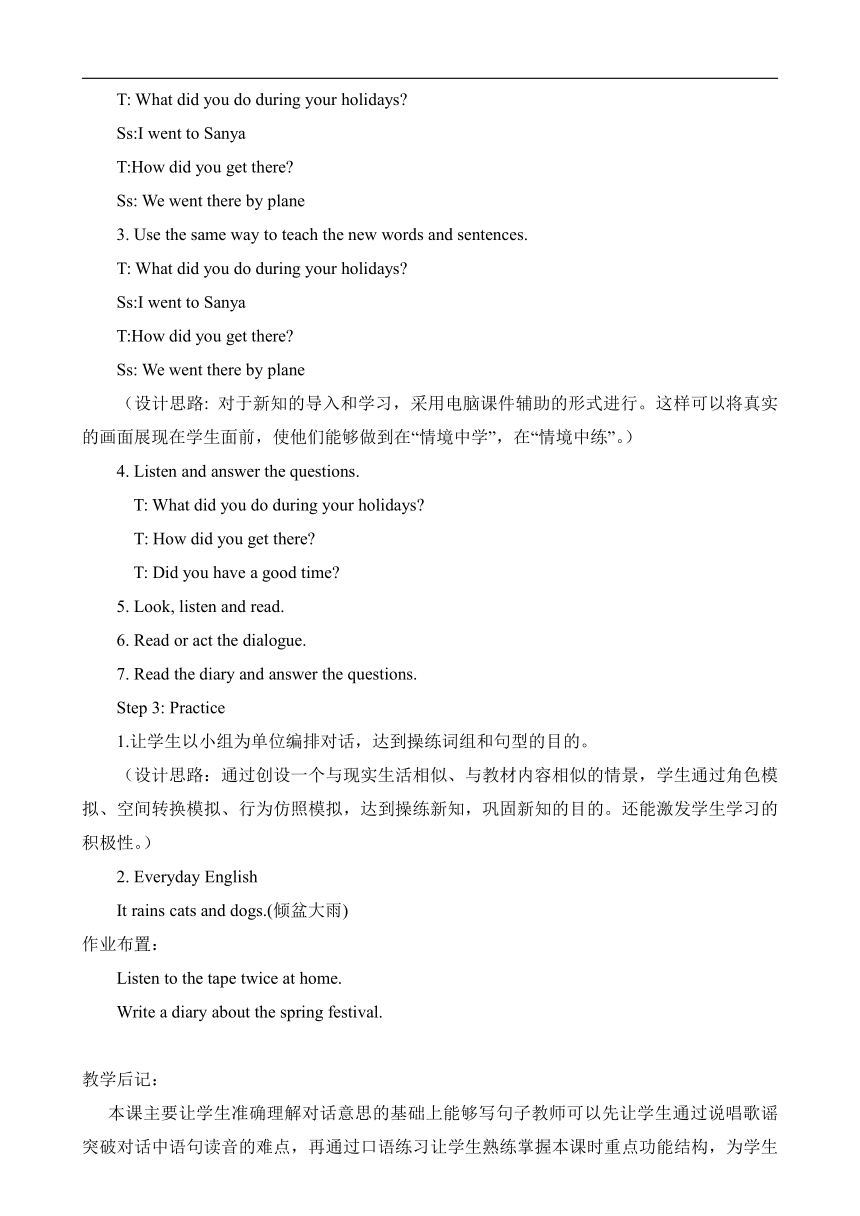
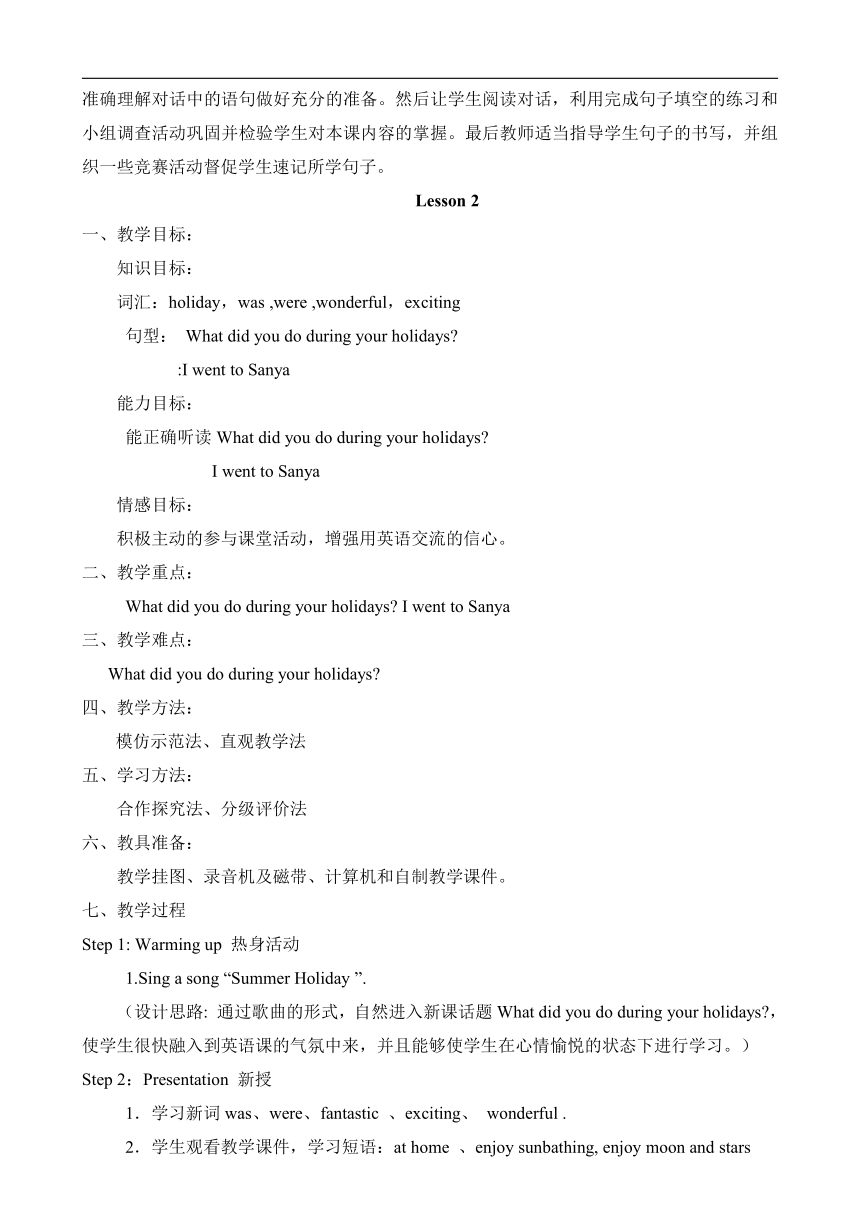
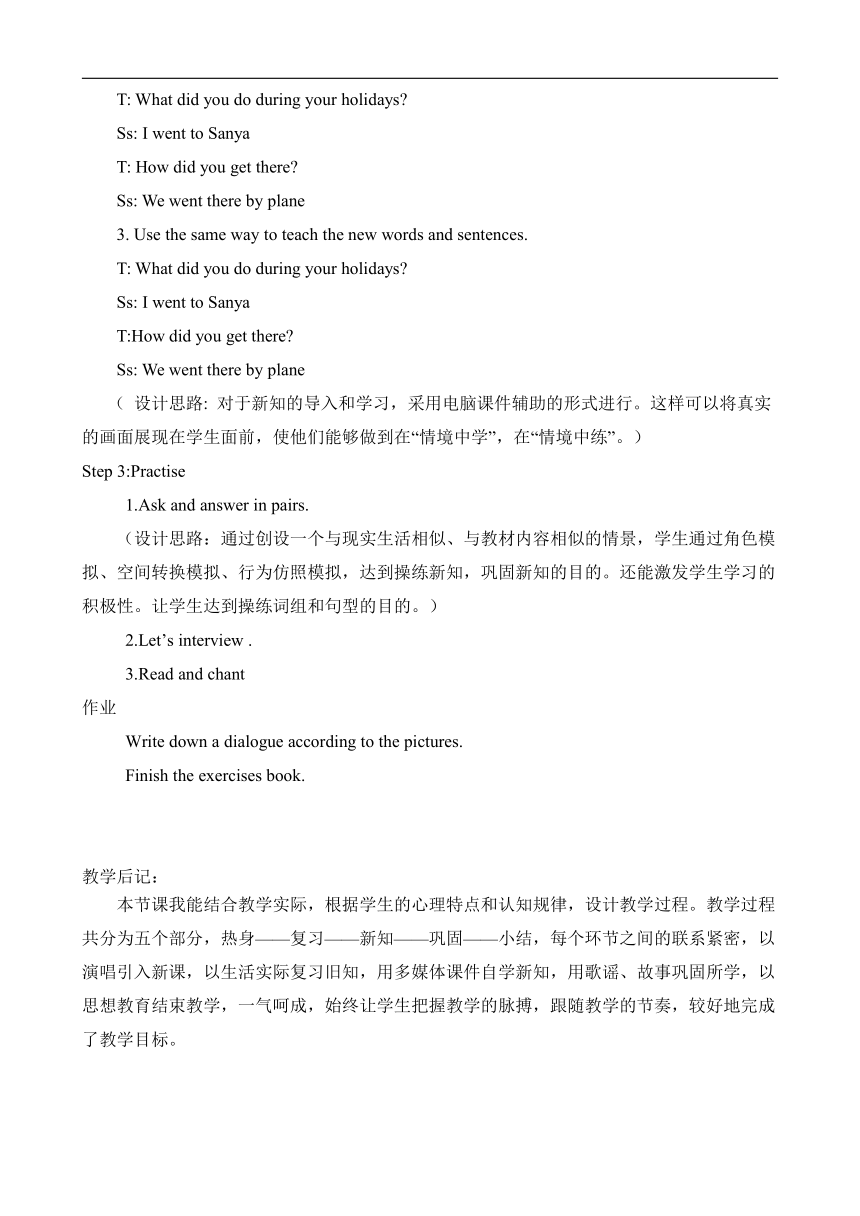
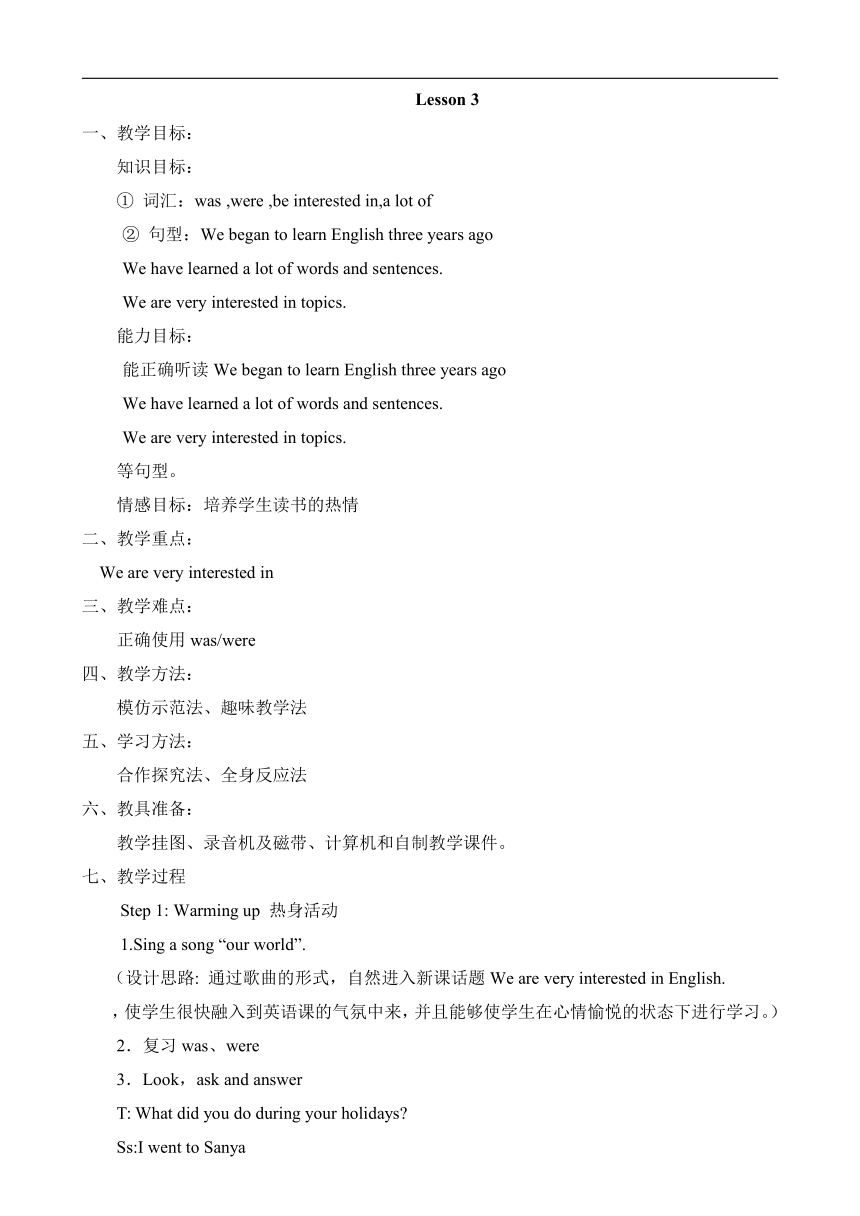
文档简介
Unit1 I went to Sanya for my holidays
Lesson 1
一、教学目标
知识目标:
词汇:holiday,was ,were ,did
句型:What did you do during your holidays?
能力目标:
能正确听读What did you do during your holidays?
Did you have a good time?
I watched TV on the eve of the Spring Festival.
情感态度:
能够运用所学知识表达生活中有意义的经历及情感状态。
二、教学重点:
What did you do during your holidays?.
三、教学难点:
正确使用was/were
四、教学方法:
情景教学法、直观教学法、活动教学法
五、学习方法:
合作学习法、听说训练法
六、教具准备:
教学挂图、录音机及磁带、计算机和自制教学课件。
七、教学过程
Step 1: Warming up 热身活动
Sing a song “Summer Holiday ”.
(设计思路: 通过歌曲的形式,自然进入新课话题What did you do during your holidays?使学生很快融入到英语课的气氛中来,并且能够使学生在心情愉悦的状态下进行学习。)
Step 2:Presentation 新授
1.学习新词was、were、enjoy.
2.学生观看教学课件,学习短语:in Beijing,
T: What did you do during your holidays?
Ss:I went to Sanya
T:How did you get there?
Ss: We went there by plane
3. Use the same way to teach the new words and sentences.
T: What did you do during your holidays?
Ss:I went to Sanya
T:How did you get there?
Ss: We went there by plane
(设计思路: 对于新知的导入和学习,采用电脑课件辅助的形式进行。这样可以将真实的画面展现在学生面前,使他们能够做到在“情境中学”,在“情境中练”。)
4. Listen and answer the questions.
T: What did you do during your holidays?
T: How did you get there?
T: Did you have a good time?
5. Look, listen and read.
6. Read or act the dialogue.
7. Read the diary and answer the questions.
Step 3: Practice
1.让学生以小组为单位编排对话,达到操练词组和句型的目的。
(设计思路:通过创设一个与现实生活相似、与教材内容相似的情景,学生通过角色模拟、空间转换模拟、行为仿照模拟,达到操练新知,巩固新知的目的。还能激发学生学习的积极性。)
2. Everyday English
It rains cats and dogs.(倾盆大雨)
作业布置:
Listen to the tape twice at home.
Write a diary about the spring festival.
教学后记:
本课主要让学生准确理解对话意思的基础上能够写句子教师可以先让学生通过说唱歌谣突破对话中语句读音的难点,再通过口语练习让学生熟练掌握本课时重点功能结构,为学生准确理解对话中的语句做好充分的准备。然后让学生阅读对话,利用完成句子填空的练习和小组调查活动巩固并检验学生对本课内容的掌握。最后教师适当指导学生句子的书写,并组织一些竞赛活动督促学生速记所学句子。
Lesson 2
一、教学目标:
知识目标:
词汇:holiday,was ,were ,wonderful,exciting
句型: What did you do during your holidays?
:I went to Sanya
能力目标:
能正确听读What did you do during your holidays?
I went to Sanya
情感目标:
积极主动的参与课堂活动,增强用英语交流的信心。
二、教学重点:
What did you do during your holidays? I went to Sanya
三、教学难点:
What did you do during your holidays?
四、教学方法:
模仿示范法、直观教学法
五、学习方法:
合作探究法、分级评价法
六、教具准备:
教学挂图、录音机及磁带、计算机和自制教学课件。
七、教学过程
Step 1: Warming up 热身活动
1.Sing a song “Summer Holiday ”.
(设计思路: 通过歌曲的形式,自然进入新课话题What did you do during your holidays?,使学生很快融入到英语课的气氛中来,并且能够使学生在心情愉悦的状态下进行学习。)
Step 2:Presentation 新授
1.学习新词was、were、fantastic 、exciting、 wonderful .
2.学生观看教学课件,学习短语:at home 、enjoy sunbathing, enjoy moon and stars
T: What did you do during your holidays?
Ss: I went to Sanya
T: How did you get there?
Ss: We went there by plane
3. Use the same way to teach the new words and sentences.
T: What did you do during your holidays?
Ss: I went to Sanya
T:How did you get there?
Ss: We went there by plane
( 设计思路: 对于新知的导入和学习,采用电脑课件辅助的形式进行。这样可以将真实的画面展现在学生面前,使他们能够做到在“情境中学”,在“情境中练”。)
Step 3:Practise
1.Ask and answer in pairs.
(设计思路:通过创设一个与现实生活相似、与教材内容相似的情景,学生通过角色模拟、空间转换模拟、行为仿照模拟,达到操练新知,巩固新知的目的。还能激发学生学习的积极性。让学生达到操练词组和句型的目的。)
2.Let’s interview .
3.Read and chant
作业
Write down a dialogue according to the pictures.
Finish the exercises book.
教学后记:
本节课我能结合教学实际,根据学生的心理特点和认知规律,设计教学过程。教学过程共分为五个部分,热身——复习——新知——巩固——小结,每个环节之间的联系紧密,以演唱引入新课,以生活实际复习旧知,用多媒体课件自学新知,用歌谣、故事巩固所学,以思想教育结束教学,一气呵成,始终让学生把握教学的脉搏,跟随教学的节奏,较好地完成了教学目标。
Lesson 3
一、教学目标:
知识目标:
① 词汇:was ,were ,be interested in,a lot of
② 句型:We began to learn English three years ago
We have learned a lot of words and sentences.
We are very interested in topics.
能力目标:
能正确听读We began to learn English three years ago
We have learned a lot of words and sentences.
We are very interested in topics.
等句型。
情感目标:培养学生读书的热情
二、教学重点:
We are very interested in
三、教学难点:
正确使用was/were
四、教学方法:
模仿示范法、趣味教学法
五、学习方法:
合作探究法、全身反应法
六、教具准备:
教学挂图、录音机及磁带、计算机和自制教学课件。
七、教学过程
Step 1: Warming up 热身活动
1.Sing a song “our world”.
(设计思路: 通过歌曲的形式,自然进入新课话题We are very interested in English.
,使学生很快融入到英语课的气氛中来,并且能够使学生在心情愉悦的状态下进行学习。)
2.复习was、were
3.Look,ask and answer
T: What did you do during your holidays?
Ss:I went to Sanya
T:How did you get there?
Ss: We went there by plane
Step 2:Presentation 新授
1.Look,listen and read .
We are very interested in English.
We have learned a lot of words and sentences.
(设计思路: 对于新知的导入和学习,采用电脑课件辅助的形式进行。这样可以将真实的画面展现在学生面前,使他们能够做到在“情境中学”,在“情境中练”。)
2.Read in pairs .
3.Read or act in pairs.
Step 3:Practise
1.Talk about “English learning”
(设计思路:通过创设一个 真实情景,达到操练新知,巩固新知的目的。还能激发学生学习的积极性。让学生达到操练词组和句型的目的。)
2.Let students report their dialogues.
师生互评,生生互评。
3.Everyday English.
读万卷书,行万里路。
Reading ten thousand books is like traveling ten thousand miles.
书籍是伟大的精神粮食。
Books are the food for the hungry of great mind.
作业布置:
Listen to the tape twice at home.
Write a diary about the spring festival.
教学后记:
本课主要是学习词汇,在这个时候我们教师应考虑到所任教学科的特点及高年级小学生的性格特点,有必要对自己的课堂陈述进行反思。因此,在课堂上教师要掌握优美的英语语调,形成亲切得体的教姿教态,提升自己的教学魅力。新知导入时,可让学生描述教师,或进行一些口头拼读练习。学生在操练时,要注意让他们使用所学的新知识。
Lesson 4
一、教学目标:
知识目标:
词汇:listen to ,speak ,read , write ,talk ,play
句型:We are very interested in English.
We have learned a lot of words and sentences.
能力目标:
能正确听读和使用was、were、listen to ,speak ,read , write ,talk,play等动词不定式,熟练正确运动句型We are very interested in English. We have learned a lot of words and sentences.
二、教学重点:
句型:We are very interested in English.
We have learned a lot of words and sentences.
三、教学难点:
We have learned a lot of words and sentences.
四、教学方法:
直观教学法、激励教学法、活动教学法
五、学习方法:
合作学习法、模仿示范法
六、教具准备:
教学挂图、录音机及磁带、计算机和自制教学课件。
七、教学过程
Step 1: Warming up 热身活动
1.Sing a song.
(设计思路: 通过歌曲的形式,自然进入新课话题We are very interested in English.使学生很快融入到英语课的气氛中来,并且能够使学生在心情愉悦的状态下进行学习。)
2.复习was、were
Step 2:Presentation 新授
1.Use the pictures to teach the words and phrases: at the shop/at the bookshop(bookstore)/at the cinema/at the science museum
(设计思路: 对于新知的导入和学习,采用电脑课件辅助的形式进行。这样可以将真实的画面展现在学生面前,使他们能够做到在“情境中学”,在“情境中练”。)
2.Ask and answer in pairs .
We are very interested in English.
We have learned a lot of words and sentences.
(设计思路:通过创设一个真实情景,达到操练新知,巩固新知的目的。还能激发学生学习的积极性。让学生达到操练词组和句型的目的。)
3.A guessing game .
We are very interested in listening to English/speaking English
Step 3:Practise
1、Just write教师示范,学生点评;学生书写,小组内互评。
2、Let’s act
3、Read and chant
作业布置:
1.Recite the words and phrases.
2.Write the words and sentences .
教学后记:
本课主要是在学生能够在读懂对话的基础上,正确写出所学句子。要求学生动手动脑动口,根据图片出示的句子,制作两组单词卡片,并进行对话练习。学新知导入时,可让学生描述教师,或进行一些口头拼读练习。学生在操练时,要注意让他们使用所学的新知识。
Lesson 5
一、教学目标:
知识目标:
词汇:learn, teach, tell, use begin
句型:How did you learn English?
We learned English by doing things.
We helped each other and learned from each other.
能力目标:
能听懂和使用本课的句型:How did you learn English?
We learned English by doing things.
We helped each other and learned from each other.
情感目标:
使用英语交际的热情和信心的培养。
二、教学重点:
How did you learn English?
We learned English by doing things.
We helped each other and learned from each other.
三、教学难点:
How did you learn English?
We learned English by doing things....
四、教学方法:
情景教学法、直观教学法、分级评价法
五、学习方法:
小组合作探究、全身反应法
六、教具准备:
教学挂图、录音机及磁带、计算机和自制教学课件。
七、教学过程
Step 1: Warming up 热身活动
1.Sing a song.
(设计思路: 通过歌曲的形式,自然进入新课话题How did you learn English?,使学生很快融入到英语课的气氛中来,并且能够使学生在心情愉悦的状态下进行学习。)
2.复习was、were
3. Ask and answer
Step 2:Presentation 新授
1、How did you learn English?
We learned English by doing things.
(设计思路: 对于新知的导入和学习,采用电脑课件辅助的形式进行。这样可以将真实的画面展现在学生面前,使他们能够做到在“情境中学”,在“情境中练”。)
2、Listen and answer the questions
How did you learn English?
We learned English by doing things.
We learned English by listening to English.
We learned English by reading English
….
3、Look ,Listen and read
4、Read in pairs .
Step 3: Practice
1、Make up a new dialogue .
(设计思路:通过创设一个 真实情景,达到操练新知,巩固新知的目的。还能激发学生学习的积极性。让学生达到操练词组和句型的目的。)
2、师生、生生互评。
作业布置:
1、Interview your family and friends
How did you learn English?
We learned English by...
2、Report in groups.
教学后记:
英语教师的教学重点是放在教学内容,教学大纲和考试形式上呢,还是将教学注重点转移到学生的性格、兴趣、情绪等方面的培养和控制?这是,现代教育思想转变的重大原则问题。事实证明,认为自己“民主、开放、平静、友好、体贴、乐于助人、聪明、富于逻辑性和快乐”的人,一般来说,其学习英语成功的可能性要大于与上述性格相反或相差极大的学习者。另外,在外语学习过程中,由于外界因素的影响,学习者会出现焦虑沮丧烦躁不安等情况,英语教师作为教学活动的组织者,应注意对外语学习者情感因素的培养和控制。尤其是在小学阶段,英语教师要培养对学生的亲近感。在课堂教学中英语教师要十分尊重学生,注意激励学生,关注学生学习过程。在当前“减负”工作中,英语教师尤其要注意体察学生在课堂上的心理感受,亲近学生,使学生喜爱英语教师和英语课,从而提高英语课堂教学的效益。
Lesson 6
一、教学目标:
知识目标:
词汇:do tasks,have an English party,act in drama,learn from each other
句型:How did you learn English?
We learned English by doing things.
We learned from each other.
能力目标:
能听懂和使用本课的句型:How did you learn English?
We learned English by doing things. We learned from each other.
情感目标:
使用英语交际的热情和信心的培养。
二、教学重点:
How did you learn English?
We learned English by doing things.
We learned from each other.
三、教学难点:
How did you learn English?
四、教学方法:
情景教学法、直观教学法、分级评价法
五、学习方法:
小组合作探究、全身反应法
六、教具准备:
教学挂图、录音机及磁带、计算机和自制教学课件。
七、教学过程
Step 1: Warming up 热身活动
1.Sing a song “Summer Holiday ”.
(设计思路: 通过歌曲的形式,自然进入新课话题How did you learn English?,使学生很快融入到英语课的气氛中来,并且能够使学生在心情愉悦的状态下进行学习。)
2.复习was、were
3. Ask and answer
Step 2:Presentation 新授
1、Use the pictures to teach the words and Sentences:
How did you learn English?
We learned English by doing things.
We learned from each other.
(设计思路: 对于新知的导入和学习,采用电脑课件辅助的形式进行。这样可以将真实的画面展现在学生面前,使他们能够做到在“情境中学”,在“情境中练”。)
2、复习句型:
What did you do during your holidays?
I went to Sanya
How did you get there?
We went there by plane
We are very interested in English.
We have learned a lot of words and sentences.
Step 3: Practice
1、出示四组课件练习以上句型。
(设计思路:通过创设一个 真实情景,达到操练新知,巩固新知的目的。还能激发学生学习的积极性。让学生达到操练词组和句型的目的。)
2、Let’s do a survey.
3、师生、生生互评。
作业布置:
Look for the information about dinosaurs.
Write sth. about the dinosaurs.
教学反思
教学后记:
小学英语教学是要重视培养兴趣,但不能单靠唱 ,玩 ,单靠唱歌游戏不能培养学生持久的兴趣。新鲜劲儿一过孩子们就会厌倦。所以,唱歌游戏应该作为小学生学习英语语言知识、技能的一些手段,而不是培养兴趣的手段。我们可以采用多种手段帮助小学生在记忆力强的时期多记单词,多学习语言规则,并尽可能多创造模仿的机会,提高学生的语音和语调。在英语学习中,听、说、读、写、译五种能力是可以互补的。真正做到听说先行,读写跟上。光听说不读写,很难收到高效。只靠模仿不培养学习能力,也难减轻学习负担。
同课章节目录
- Unit 1 I went to Sanya for my holidays.
- Lesson 1
- Lesson 2
- Lesson 3
- Lesson 4
- Lesson 5
- Lesson 6
- Unit 2 There is a park near my home.
- Lesson 7
- Lesson 8
- Lesson 9
- Lesson 10
- Lesson 11
- Lesson 12
- Unit 3 We are going to travel.
- Lesson 13
- Lesson 14
- Lesson 15
- Lesson 16
- Lesson 17
- Lesson 18
- Fun Time 1
- Recycle 1
- Recycle 2
- Fun Reading
- Unit 4 General Revision 1
- Task 1-Task 2
- Task 3-Task 4
- Task 5-Task 6
- Task 7-Task 8
- Task 9-Task 10
- Task 11-Task 12
- Unit 5 General Revision 2
- Task 1-Task 2
- Task 3-Task 4
- Task 5-Task 6
- Task 7-Task 8
- Task 9-Task 10
- Task 11-Task 12
- Unit 6 General Revision 3
- Task 1-Task 2
- Task 3-Task 4
- Task 5-Task 6
- Task 7-Task 8
- Task 9-Task 10
- Task 11
- 旧版资料
- Unit 1 How was your holiday?
- Unit 2 Let's talk about the past.
- Unit 4 We are going to visit the Great Wall.
- Unit 5 Save our planet.
- Unit 6 How do you learn?
